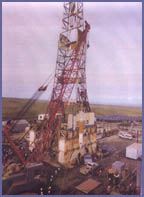Long Shot, Milrow and Cannikin descriptions and historical videos
by Doug Schneider, Alaska Sea Grant College Program

A tower was constructed at the Amchitka test site for lowering the nuclear weapon into the underground shaft.Historical photo courtesy Mark Johnson, UAF.
In all, three nuclear devices--code named Long Shot, Milrow and Cannikin--were detonated beneath the island in 1965, 1969 and 1971, respectively.
- Long Shot: An 80 kiloton bomb, equal to 80,000 tons of TNT, was detonated Oct. 29, 1965, in
a shaft 710 meters deep. The test was conducted to help scientists develop and test
equipment to be used to detect the nuclear blasts of other nations and to differentiate
nuclear events from seismic events such as earthquakes.
View historical video of the Long Shot blast.
- Milrow: A 1.2 megaton bomb, equal to 1.2 million tons of TNT, was detonated Oct. 2, 1969
in a shaft 1,219 meters deep. This test was conducted to help scientists understand
the potential impact of even larger tests being planned.
View historical video of the Milrow blast.
- Cannikin: A 5 megaton bomb, equal to 5 million tons of TNT, was detonated Nov. 6, 1971 in
a shaft 1,791 meters deep,. The Cannikin blast, 400 times more powerful than the nuclear
bomb dropped on Hiroshima, Japan in 1945, was the largest nuclear test ever conducted
by the United States. The shock wave it generated equaled an earthquake registering
7.0 on the Richter scale. Witnesses said the entire island undulated some 20 feet.
Slumping over the blast site created a lake one mile wide and 40 feet deep. The test
was conducted to confirm the reliability of the nation’s Spartan nuclear missile system,
a system that by some expert accounts of the time was obsolete at the time of the
test.
View historical video of the Cannikin blast.


